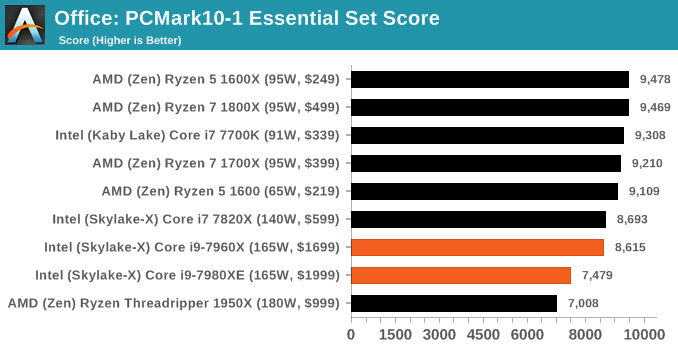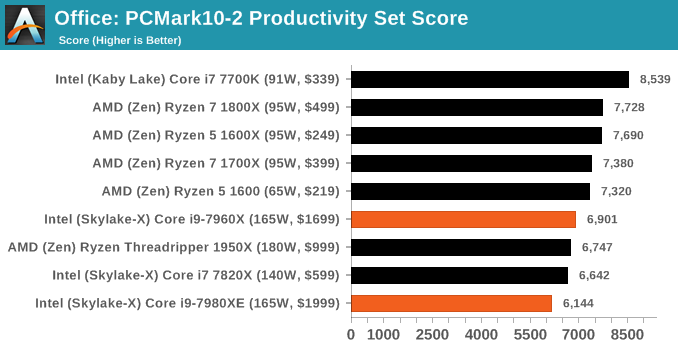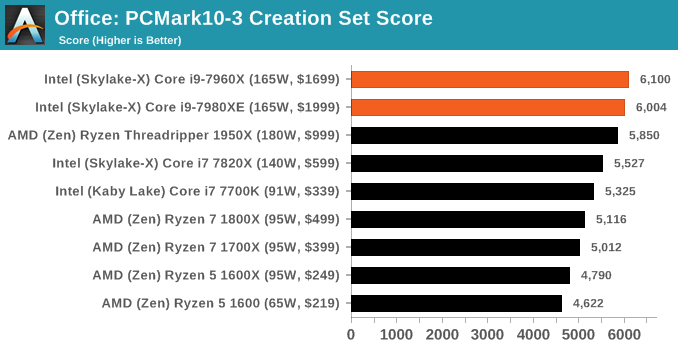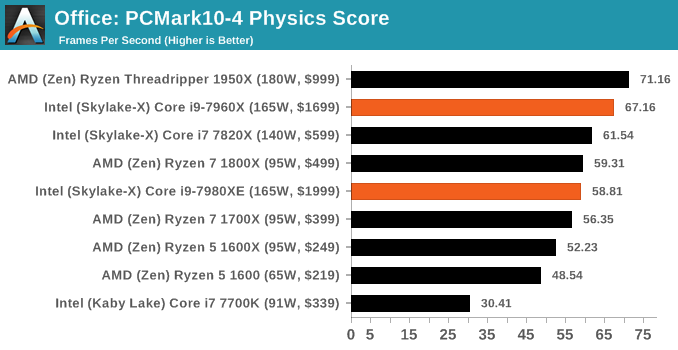The Intel Core i9-7980XE and Core i9-7960X CPU Review Part 1: Workstation
by Ian Cutress on September 25, 2017 3:01 AM ESTBenchmarking Performance: PCMark 10
PCMark 10 is the 2017 update to the family favorite, PCMark 8. PCMark 8 has been part of our test bed since the latest update in Q1. For the most part it runs well, although for some processors it doesn’t recognize, some tests will not complete, leading to holes in our benchmark data (there’s also an odd directory quirk in one test that causes issues). The newest version, PCMark 10, is the answer.
The new test is adapted for more 2016/2017 workflows. With the advent of office applications that perform deeper compute tasks, or the wave of online gamers and streamers, the idea behind PCMark 10 is to give a better ‘single number’ result that can provide a comparable metric between systems. Single metrics never tell the whole story, so we’re glad that Futuremark provides a very detailed breakdown of what goes on.
Ganesh’s article on PCMark 10 goes into more detail than I will here, but the ‘Extended Benchmark’ runs through four different sets of tests: Essential, Productivity, Creation and Gaming. Each of these have sub-test results as well, including startup performance, web performance, video conferencing, photo/video editing, spreadsheets, rendering, and physics, which you can find in Bench.














152 Comments
View All Comments
Notmyusualid - Tuesday, September 26, 2017 - link
@ vladxTry telling that to the fanbios here...
For some of us, price is not the main consideration.
HStewart - Monday, September 25, 2017 - link
I have a big issue with latest performance results - especially dealing with multi-core performance. What is most important is single core performance - this primary because real applications and not benchmark application use the primary thread more that secondary threads. Yes the secondary threads do help in calculations and such - but most important especially in graphical application is using the primary thread. Plus quality is important - I not sure AMD is going to last in this world - because they seem to have a very limited focus.HStewart - Monday, September 25, 2017 - link
Especially GeekBench - I don't trust it all - realistically can an ARM processor beat huge Xeon processor. Give me break - lets be realistic.Krysto - Monday, September 25, 2017 - link
Intel is failing hard at competing, if it can only release chips that cost twice as much as AMD's for only a slight improvement in performance.vladx - Tuesday, September 26, 2017 - link
On the contrary, these chips will sell very well since they aren't geared towards "prosumers" but big businesses where every minute wasted could mean thousands $$ lost.willis936 - Monday, September 25, 2017 - link
That performance ler dollar page is amazing. I could look at graphs like that comparing all types of compinents and configurations against different workloads all day.Judas_g0at - Monday, September 25, 2017 - link
I didn't see anything about temp and thermals. For 2k, does Intel give you crappy thermal compound, or solder?Spunjji - Monday, September 25, 2017 - link
Spoiler alert: I hope you like cleaning toothpaste off your $1999 CPU.shabby - Monday, September 25, 2017 - link
Lol platform pcie lanes, good one intel, how many does threadripper have in this case?DanNeely - Monday, September 25, 2017 - link
TR has 60 platform PCIe3 lanes, 68 total if you count the 8 half speed PCIe2 lanes on the x399 chipset.